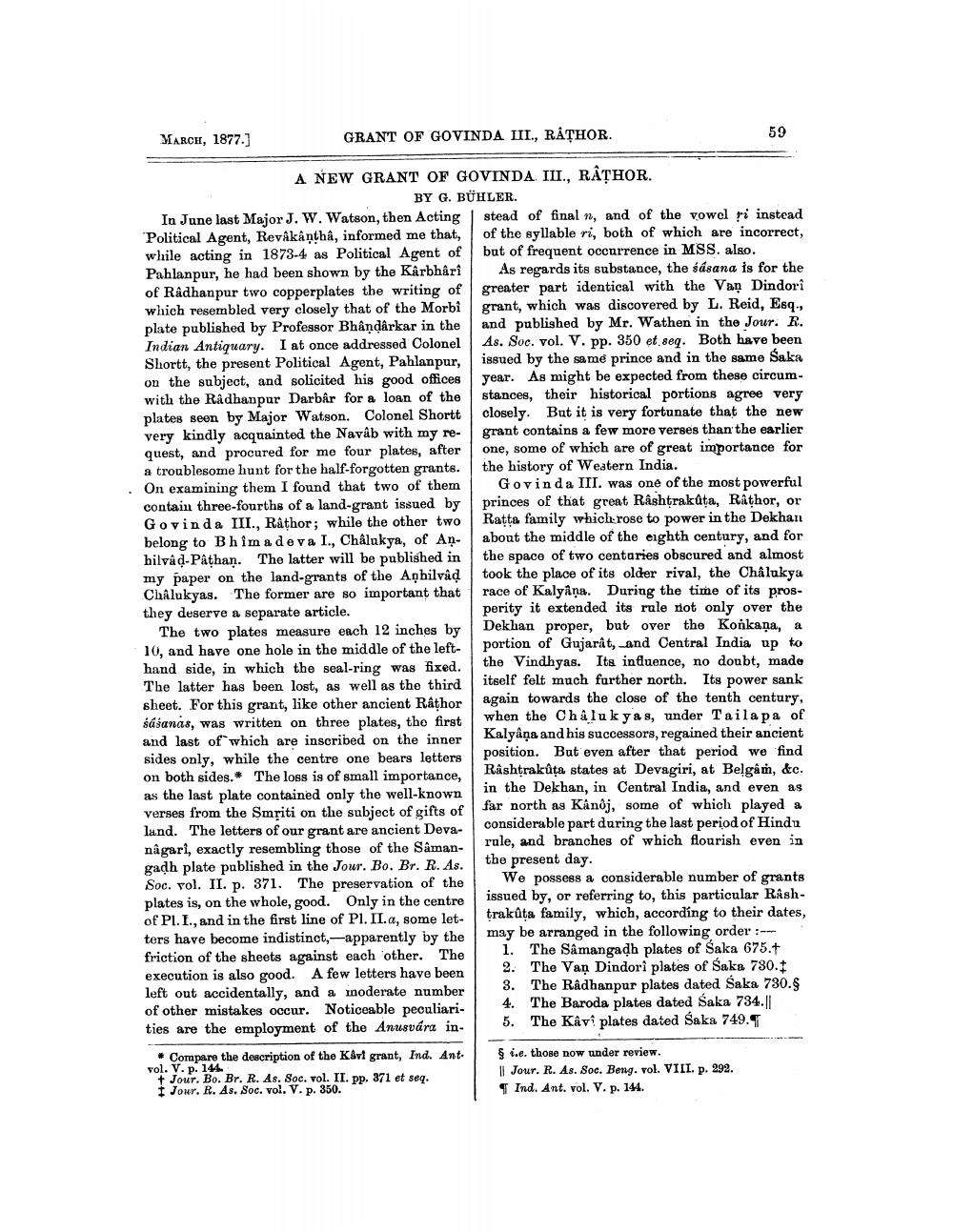________________
MARCH, 1877.]
GRANT OF GOVINDA III., RÅTHOR.
59
A NEW GRANT OF GOVINDA. III., RÂTHOR.
BY G. BÜHLER. In June last Major J. W. Watson, then Acting stead of final n, and of the vowel ri instead Political Agent, Revâkântha, informed me that, of the syllable ri, both of which are incorrect, while acting in 1873-4 as Political Agent of but of frequent occurrence in MSS. also. Pahlanpur, he had been shown by the Kårbhâri As regards its substance, the sásana is for the of Rådhanpur two copperplates the writing of greater part identical with the Van Dindori which resembled very closely that of the Morbi grant, which was discovered by L. Reid, Esq.. plate published by Professor Bhandarkar in the and published by Mr. Wathen in the Jour. R. Indian Antiquary. I at once addressed Colonel As. Soc. vol. V. pp. 350 et seq. Both have been Shortt, the present Political Agent, Pahlanpur, issued by the same prince and in the same Saka on the subject, and solicited his good offices year. As might be expected from these circumwith the Rådhanpur Darbar for a loan of the stances, their historical portions agree very plates seen by Major Watson. Colonel Shortt closely. But it is very fortunate that the new very kindly acquainted the Navab with my re- grant contains a few more verses than the earlier quest, and procured for me four plates, after one, some of which are of great importance for a troublesome hunt for the half-forgotten grants. the history of Western India. On examining them I found that two of them Govinda III. was one of the most powerful contain three-fourths of a land-grant issued by princes of that great Rashtrakūta, Rathor, or Govinda III., Rathor; while the other two Ratta family which rose to power in the Dekhan belong to Bhimadeva I., Châlukya, of An- about the middle of the eighth century, and for hilva d-Pathan. The latter will be published in the space of two centaries obscured and almost my paper on the land-grants of the A hilvad took the place of its older rival, the Châlukya Chalukyas. The former are so important that race of Kalyana. During the time of its prosthey deserve a separate article.
perity it extended its rule not only over the The two plates measure each 12 inches by
Dekhan proper, but over the Konkana, a 10, and have one hole in the middle of the left
portion of Gujarât, and Central India up to hand side, in which the seal-ring was fixed.
the Vindhyas. Its influence, no doubt, made The latter has been lost, as well as the third
itself felt much further north. Its power sank sheet. For this grant, like other ancient Rathor
again towards the close of the tenth century, sasanas, was written on three plates, tho first
when the Chåluk yas, under Taila pa of and last of which are inscribed on the inner
Kalyana and his successors, regained their ancient sides only, while the centre one bears letters
position. But even after that period we find on both sides. The loss is of small importance,
Rashtrakūta states at Devagiri, at Belgâm, &c. as the last plate contained only the well-known
in the Dekhan, in Central India, and even as verses from the Smriti on the subject of gifts of
far north as Kanoj, some of which played a land. The letters of our grant are ancient Deva
considerable part during the last period of Hindu någari, exactly resembling those of the Saman
rule, and branches of which flourish even in gadh plate published in the Jour. Bo. Br. R.As.
the present day Soc. vol. II. p. 371. The preservation of the
We possess a considerable number of grants plates is, on the whole, good. Only in the centre issued by, or referring to this particular Rashof PL. I., and in the first line of Pl. II.a, some let- trakata family, which, according to their dates, tors have become indistinct,--apparently by the may be arranged in the following order :friction of the sheets against each other. The
1. The Sâmangadh plates of Saka 675.+ execution is also good. A few letters have been
2. The Van Dindori plates of Saks 730. left out accidentally, and a noderate number
3. The Râdhanpur plates dated Saka 730. of other mistakes occur. Noticeable peculiari
4. The Baroda plates dated Saka 734.|| ties are the employment of the Anusvára in.
5. The Kâvî plates dated Śaka 749.
• Compare the description of the Kavi grant, Ind. Ant. vol. V. p. 144.
+ Jour. Bo. Br. R. As. Soc. vol. II. pp. 371 et seq. I Jour. R. As. Soc. vol. V. p. 350.
§ i.e. those now under review. Il Jour. R. As. Soc. Beng. vol. VIII. p. 292.
Ind. Ant. vol. V. p. 144.




